

Vertebrata Palasiatica ›› 2021, Vol. 59 ›› Issue (4): 273-294.DOI: 10.19615/j.cnki.2096-9899.210715
Previous Articles Next Articles
DONG Wei1,2( ), BAI Wei-Peng1,2,3, ZHANG Li-Min1,2,3
), BAI Wei-Peng1,2,3, ZHANG Li-Min1,2,3
Received:2021-03-26
Online:2021-10-20
Published:2021-10-18
通讯作者:
* dongwei@ivpp.ac.cn基金资助:CLC Number:
DONG Wei, BAI Wei-Peng, ZHANG Li-Min. The first description of Rhinocerotidae (Perissodactyla, Mammalia) from Xinyaozi Ravine in Shanxi, North China. Vertebrata Palasiatica, 2021, 59(4): 273-294.
董为, 白炜鹏, 张立民. 2021, 59(4): 273-294, 山西天镇辛窑子早更新世犀科化石新材料. 古脊椎动物学报.
Add to citation manager EndNote|Ris|BibTeX
URL: https://www.vertpala.ac.cn/EN/10.19615/j.cnki.2096-9899.210715
| Taxon | Elasmotherium peii | E. cf. E. peii | E. caucasicum | E. sibiricum | ||||||
|---|---|---|---|---|---|---|---|---|---|---|
| Location | Xinyaozi | Shanshenmiaozhui1) | Xihoudu2) | Stavropol Krai3) | Salcia4) | Taman5) | Stavropol Krai3) | |||
| m2 L | 74.44 | 75 | 75.5 | 70-77 | 70-77 | 70-95 | 64.2-84 | |||
| m2 W | 40.58 | 40 | 43 | 41.5-60 | 34-36 | 39-50 | 34-43.5 | |||
| m2 H | 29.12(92) | 104 | 44-77 | |||||||
| m3 L | 82.36 | 72-84 | 60-98 | |||||||
| m3 W | 37.78 | 33 | 30-44 | |||||||
| m3 H | 31.28(140) | 129-130 | ||||||||
| Taxon | Elasmotherium peii | E. cf. E. peii | E. caucasicum | E. sibiricum | ||||||
|---|---|---|---|---|---|---|---|---|---|---|
| Location | Xinyaozi | Shanshenmiaozhui1) | Xihoudu2) | Stavropol Krai3) | Salcia4) | Taman5) | Stavropol Krai3) | |||
| m2 L | 74.44 | 75 | 75.5 | 70-77 | 70-77 | 70-95 | 64.2-84 | |||
| m2 W | 40.58 | 40 | 43 | 41.5-60 | 34-36 | 39-50 | 34-43.5 | |||
| m2 H | 29.12(92) | 104 | 44-77 | |||||||
| m3 L | 82.36 | 72-84 | 60-98 | |||||||
| m3 W | 37.78 | 33 | 30-44 | |||||||
| m3 H | 31.28(140) | 129-130 | ||||||||
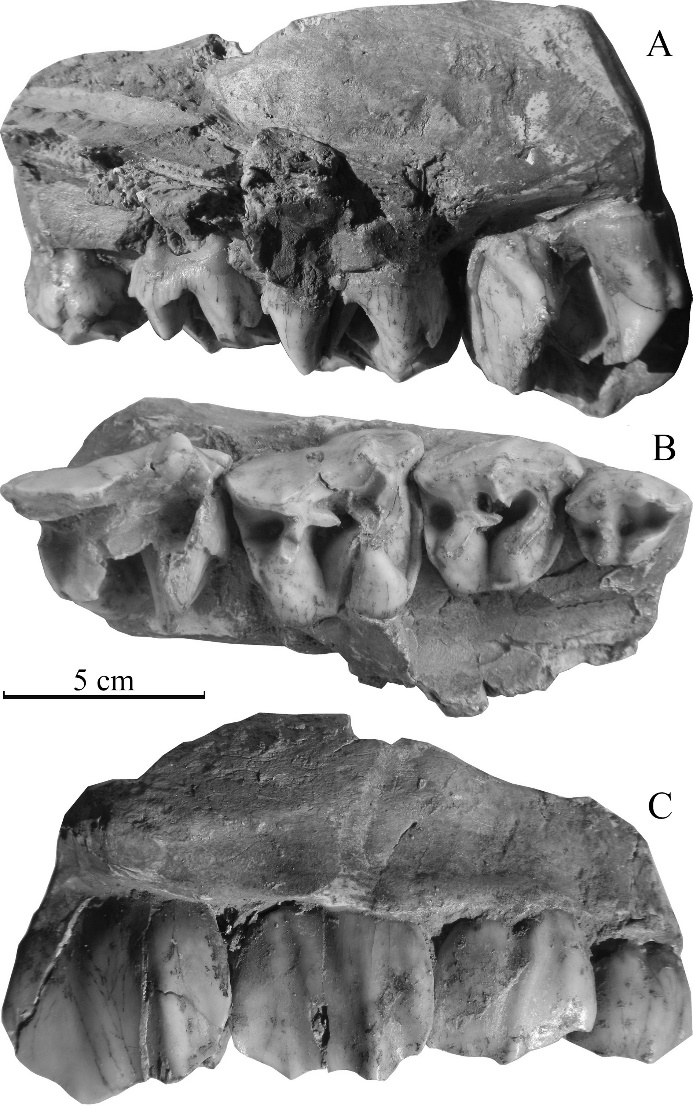
Fig. 2 A right juvenile maxillary fragment (IVPP V 27429.1) of Stephanorhinus cf. S. kirchbergensis from Xinyaozi Ravine in lingual (A), occlusal (B) and buccal (C) views
| V 27429.1 | Xiashagou1) | Rhino Cave2) | Huludong3) | Zhoukoudian4) Loc. 1 | Zhoukoudian5) Loc. 13 | West Europe6) | |
|---|---|---|---|---|---|---|---|
| DP1 L | 25.38 | 26 | 31.8-32.9 | 28-29 | 27.5 | 35 | 26-32 |
| DP1 W | 20.06 | 24 | 26-27.9 | 28 | 24-25 | 32 | 31-34 |
| DP1 H | 24.34 | 26 | |||||
| DP2 L | 35.08 | 37 | 44-47.3 | 38-39 | 36.5 | 41 | 34-39.5 |
| DP2 W | 32.76 | 40 | 42.6-47.9 | 40-42 | 39.5 | 40 | 31-43 |
| DP2 H | 28.48 | 25 | |||||
| DP3 L | 41.08 | 50.6-55.8 | 47-48 | 43.5 | 51 | 41.5-50.5 | |
| DP3 W | 39.12 | 48.2-52 | 50-52 | 49 | 53 | 42-54.5 | |
| DP3 H | 35.18 | 36.5 | |||||
| DP4 L | 49.52 | 52 | 56.6-60 | 48-52 | 47 | 53 | 48-57 |
| DP4 W | 34.24 | 51 | 52.6-54.5 | 54 | 48.5 | 56 | 51-57.5 |
| DP4 H | 42.56 | 42 | |||||
| L DP1-4 | 145.32 | 172.8-183 | 175-177 | 147 | 150 |
| V 27429.1 | Xiashagou1) | Rhino Cave2) | Huludong3) | Zhoukoudian4) Loc. 1 | Zhoukoudian5) Loc. 13 | West Europe6) | |
|---|---|---|---|---|---|---|---|
| DP1 L | 25.38 | 26 | 31.8-32.9 | 28-29 | 27.5 | 35 | 26-32 |
| DP1 W | 20.06 | 24 | 26-27.9 | 28 | 24-25 | 32 | 31-34 |
| DP1 H | 24.34 | 26 | |||||
| DP2 L | 35.08 | 37 | 44-47.3 | 38-39 | 36.5 | 41 | 34-39.5 |
| DP2 W | 32.76 | 40 | 42.6-47.9 | 40-42 | 39.5 | 40 | 31-43 |
| DP2 H | 28.48 | 25 | |||||
| DP3 L | 41.08 | 50.6-55.8 | 47-48 | 43.5 | 51 | 41.5-50.5 | |
| DP3 W | 39.12 | 48.2-52 | 50-52 | 49 | 53 | 42-54.5 | |
| DP3 H | 35.18 | 36.5 | |||||
| DP4 L | 49.52 | 52 | 56.6-60 | 48-52 | 47 | 53 | 48-57 |
| DP4 W | 34.24 | 51 | 52.6-54.5 | 54 | 48.5 | 56 | 51-57.5 |
| DP4 H | 42.56 | 42 | |||||
| L DP1-4 | 145.32 | 172.8-183 | 175-177 | 147 | 150 |
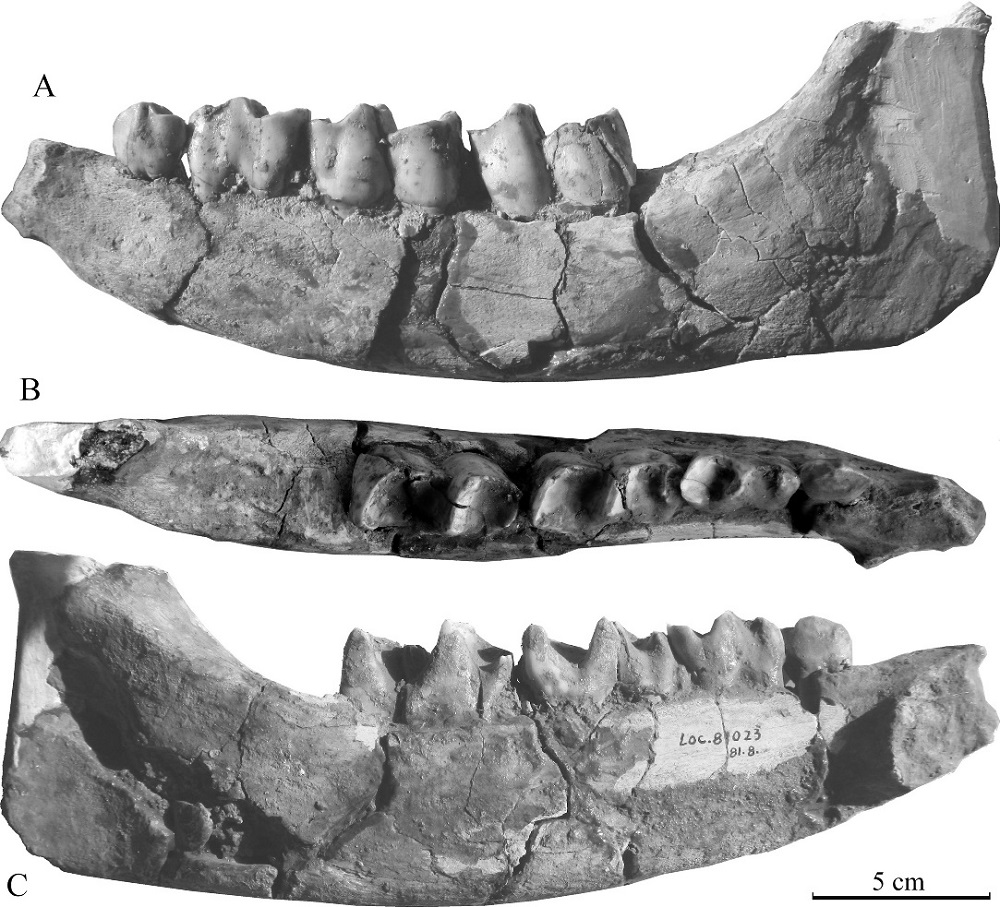
Fig. 3 A broken mandible (IVPP V 27429.3) of Stephanorhinus cf. S. kirchbergensis from Xinyaozi Ravine in buccal (A), occlusal (B) and lingual (C) views
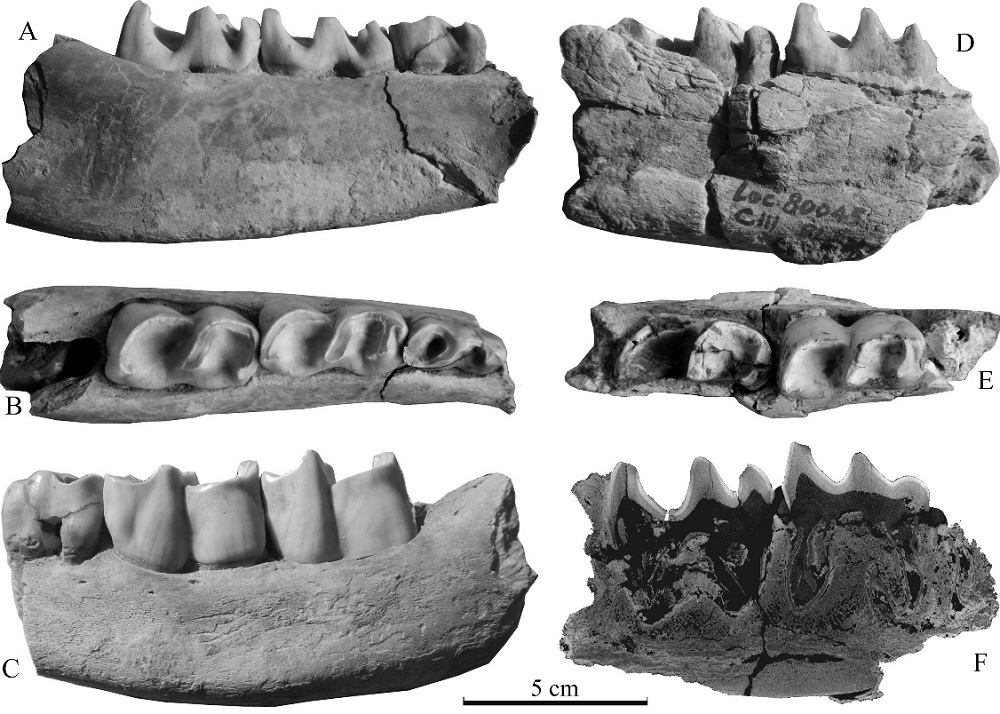
Fig. 4 Mandibular fragments (IVPP V 27429.4-5) of Stephanorhinus cf. S. kirchbergensis from Xinyaozi Ravine A-C. V 27429.4; D-F. V 27429.5; A, D. lingual view; B, E. occlusal view; C. buccal view; F. sagittal slice of CT image
| V 27429.3 | V 27429.4 | V 27429.5 | Rhino Cave1) | Loc. 13 Zhoukoudian2) | West Europe3) | |
|---|---|---|---|---|---|---|
| dp1 L | 20.56 | 23-23.4 | 21 | 17.5-23 | ||
| dp1 W | 11.38 | 11.6-13 | 13 | 14 | ||
| dp1 H | 19.82 | 18.5 | ||||
| dp2 L | 32.42 | 32.32 | 30.5-38.8 | 35 | 28-38 | |
| dp2 W | 18.44 | 18.94 | 16.7-20 | 21 | 16.5-21.5 | |
| dp2 H | 25.02 | 25.12 | ||||
| dp3 L | 44.12 | 46.98 | 45.78 | 49.2 | 44 | 38-44.5 |
| dp3 W | 23.22 | 24.98 | 25.44 | 25.1 | 26 | 21-28.5 |
| dp3 H | 28.84 | 30.26 | 32.82 | 28.5 | ||
| dp4 L | 44.82 | 45.18 | 47.68 | 49.5-52 | 47 | 42-51 |
| dp4 W | 23.22 | 27.46 | 21.54 | 27.1-27.4 | 29 | 21-31 |
| dp4 H | 32.12 | 34.14 | 23.14 | 30-35.5 | ||
| L dp1-4 | 141.68 | 182-201 |
| V 27429.3 | V 27429.4 | V 27429.5 | Rhino Cave1) | Loc. 13 Zhoukoudian2) | West Europe3) | |
|---|---|---|---|---|---|---|
| dp1 L | 20.56 | 23-23.4 | 21 | 17.5-23 | ||
| dp1 W | 11.38 | 11.6-13 | 13 | 14 | ||
| dp1 H | 19.82 | 18.5 | ||||
| dp2 L | 32.42 | 32.32 | 30.5-38.8 | 35 | 28-38 | |
| dp2 W | 18.44 | 18.94 | 16.7-20 | 21 | 16.5-21.5 | |
| dp2 H | 25.02 | 25.12 | ||||
| dp3 L | 44.12 | 46.98 | 45.78 | 49.2 | 44 | 38-44.5 |
| dp3 W | 23.22 | 24.98 | 25.44 | 25.1 | 26 | 21-28.5 |
| dp3 H | 28.84 | 30.26 | 32.82 | 28.5 | ||
| dp4 L | 44.82 | 45.18 | 47.68 | 49.5-52 | 47 | 42-51 |
| dp4 W | 23.22 | 27.46 | 21.54 | 27.1-27.4 | 29 | 21-31 |
| dp4 H | 32.12 | 34.14 | 23.14 | 30-35.5 | ||
| L dp1-4 | 141.68 | 182-201 |
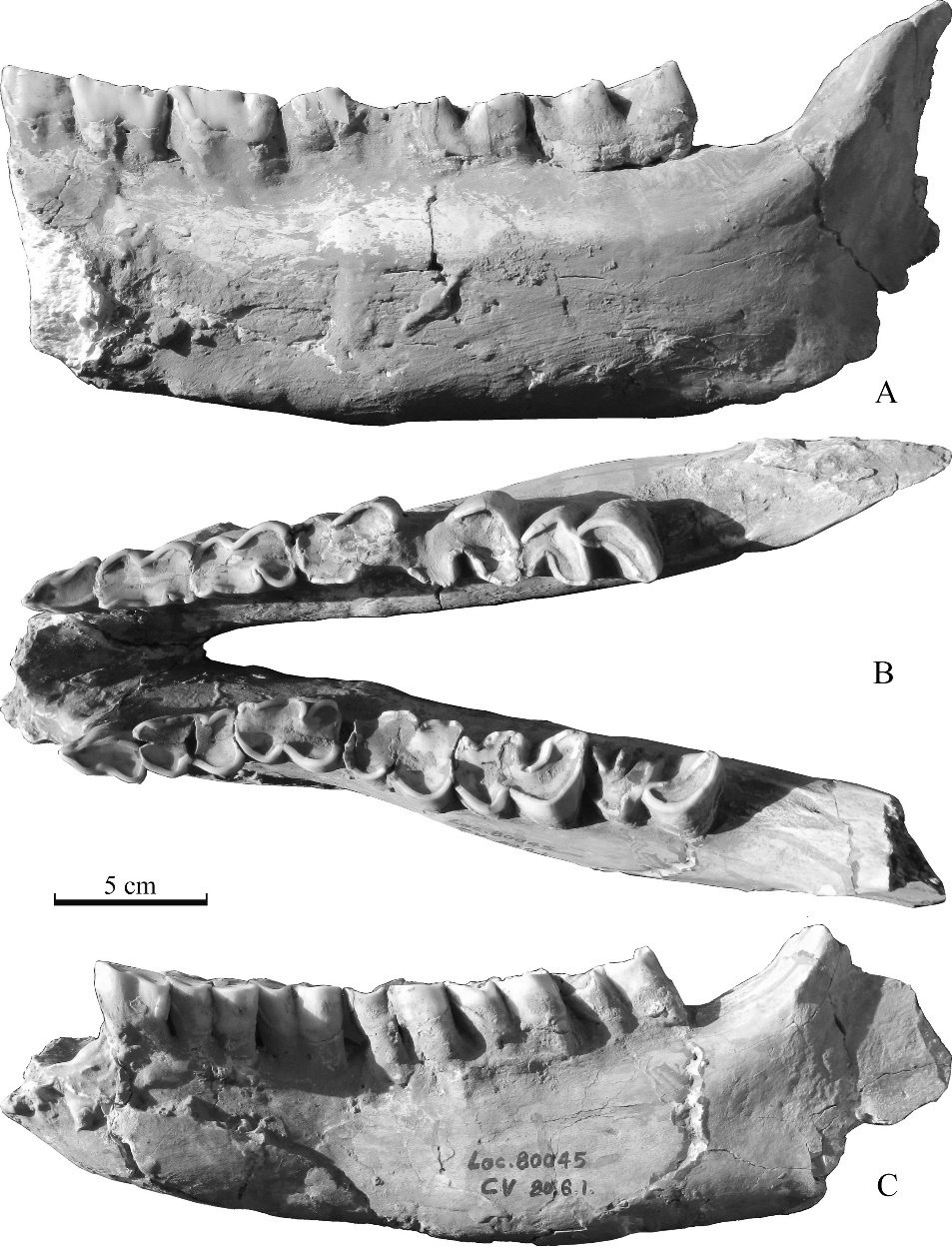
Fig. 5 Broken mandible (IVPP V 27429.2) of Stephanorhinus cf. S. kirchbergensis from Taijiaping in Xinyaozi Ravine in lingual (A), occlusal (B) and buccal (C) views
| IVPP V 27429.2 | S. kirchbergensis | |||||||
|---|---|---|---|---|---|---|---|---|
| left | right | Nihewan1) | Rhino Cave2) | Loc. 1 Zhoukoudian3) | Anping4) | West Europe5) | ||
| p2 L | 28.66 | 26.88 | 26.7-29.2 | 30.5-33.5 | 26-32 | 29.1-32.7 | 30.5-37 | |
| p2 W | 17.06 | 17.04 | 17.2-18 | 18.7-20.5 | 17-23 | 18.5-21.8 | 18.5-23 | |
| p2 H | 21.72 | 19.18 | 20-36 | 28-40 | ||||
| p3 L | 32.56 | 31.14 | 26.3 | 34.5-36.8 | 33-38 | 32.6-41.1 | 40-46.5 | |
| p3 W | 22.84 | 22.48 | 24 | 25.9-28.6 | 21-29 | 26.5-28.4 | 23.5-30 | |
| p3 H | 20.58 | 18.52 | 17-32 | 36 | ||||
| p4 L | 35.88 | 35.12 | 38-38.4 | 42-43.4 | 40-49 | 37.9-42.8 | 39-49 | |
| p4 W | 25.02 | 25.36 | 28-28.6 | 30-32.7 | 30-36 | 29.6-33.7 | 25.5-36 | |
| p4 H | 22.68 | 21.92 | 25-34 | 28.5-53 | ||||
| m1 L | 39.34 | 37.52 | 43-43.3 | 41.8-47.9 | 40-45 | 44.1-51.1 | 46.5-56 | |
| m1 W | 30.28 | 29.18 | 31.5-31.9 | 33.1-37 | 29-33 | 30.8-37.1 | 27-37 | |
| m1 H | 15.98 | 15.82 | 17-31 | 40-58 | ||||
| m2 L | 46.86 | 42.42 | 48-48.7 | 51.8-56.5 | 38-53 | 49.5-54.7 | 51-63 | |
| m2 W | 31.92 | 32.08 | 30.9-31.8 | 34.6-36.3 | 29-34 | 32.1-36.3 | 30-40 | |
| m2 H | 23.52 | 22.08 | 22-49 | 42-54 | ||||
| m3 L | 47.02 | 48.76 | 46.3-46.8 | 52.1-60.4 | 47-57 | 52.1-55.8 | 52-68 | |
| m3 W | 28.24 | 29.08 | 29.4-29.5 | 32.6-35.7 | 30-38 | 31.7-32.8 | 28-40 | |
| m3 H | 26.08 | 26.02 | 39-47 | 40-64 | ||||
| L p2-4 | 89.62 | 88.42 | ||||||
| L m1-3 | 130.42 | 129.08 | 130-137 | |||||
| L p2-m3 | 219.96 | 214.38 | 248.1 | |||||
| IVPP V 27429.2 | S. kirchbergensis | |||||||
|---|---|---|---|---|---|---|---|---|
| left | right | Nihewan1) | Rhino Cave2) | Loc. 1 Zhoukoudian3) | Anping4) | West Europe5) | ||
| p2 L | 28.66 | 26.88 | 26.7-29.2 | 30.5-33.5 | 26-32 | 29.1-32.7 | 30.5-37 | |
| p2 W | 17.06 | 17.04 | 17.2-18 | 18.7-20.5 | 17-23 | 18.5-21.8 | 18.5-23 | |
| p2 H | 21.72 | 19.18 | 20-36 | 28-40 | ||||
| p3 L | 32.56 | 31.14 | 26.3 | 34.5-36.8 | 33-38 | 32.6-41.1 | 40-46.5 | |
| p3 W | 22.84 | 22.48 | 24 | 25.9-28.6 | 21-29 | 26.5-28.4 | 23.5-30 | |
| p3 H | 20.58 | 18.52 | 17-32 | 36 | ||||
| p4 L | 35.88 | 35.12 | 38-38.4 | 42-43.4 | 40-49 | 37.9-42.8 | 39-49 | |
| p4 W | 25.02 | 25.36 | 28-28.6 | 30-32.7 | 30-36 | 29.6-33.7 | 25.5-36 | |
| p4 H | 22.68 | 21.92 | 25-34 | 28.5-53 | ||||
| m1 L | 39.34 | 37.52 | 43-43.3 | 41.8-47.9 | 40-45 | 44.1-51.1 | 46.5-56 | |
| m1 W | 30.28 | 29.18 | 31.5-31.9 | 33.1-37 | 29-33 | 30.8-37.1 | 27-37 | |
| m1 H | 15.98 | 15.82 | 17-31 | 40-58 | ||||
| m2 L | 46.86 | 42.42 | 48-48.7 | 51.8-56.5 | 38-53 | 49.5-54.7 | 51-63 | |
| m2 W | 31.92 | 32.08 | 30.9-31.8 | 34.6-36.3 | 29-34 | 32.1-36.3 | 30-40 | |
| m2 H | 23.52 | 22.08 | 22-49 | 42-54 | ||||
| m3 L | 47.02 | 48.76 | 46.3-46.8 | 52.1-60.4 | 47-57 | 52.1-55.8 | 52-68 | |
| m3 W | 28.24 | 29.08 | 29.4-29.5 | 32.6-35.7 | 30-38 | 31.7-32.8 | 28-40 | |
| m3 H | 26.08 | 26.02 | 39-47 | 40-64 | ||||
| L p2-4 | 89.62 | 88.42 | ||||||
| L m1-3 | 130.42 | 129.08 | 130-137 | |||||
| L p2-m3 | 219.96 | 214.38 | 248.1 | |||||
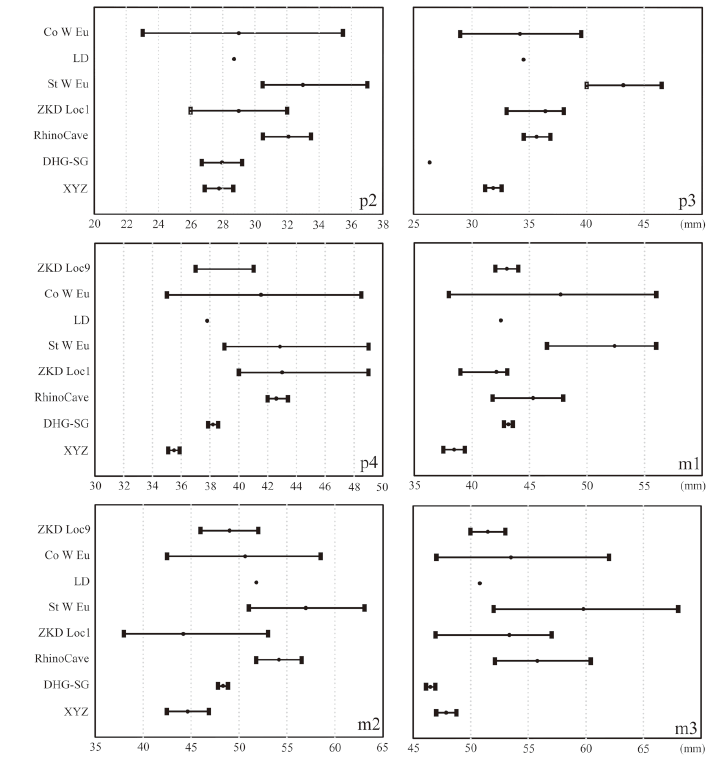
Fig. 6 Length range comparison of lower cheek teeth from selected localities Abbreviations and data sources: ZKD Loc9, Coelodonta antiquitatis from Locality 9 at Zhoukoudian (Teilhard de Chardin, 1936); Co W Eu, C. antiquitatis from West Europe (Guérin, 1980); LD, C. nihowanensis from Longdan (Qiu et al., 2004); St W Eu, Stephanorhinus kirchbergensis from West Europe (Guérin, 1980); ZKD Loc1, S. k. from Locality 1 of Zhoukoudian (Chow, 1979); RhinoCave, S. k. from Shennongjia (Tong and Wu, 2010); DHG-SG, S. k. from Daheigou and Shigou in Nihewan Basin (Tong et al., 2014); XYZ, Xinyaozi Ravine
| V 27430.1 | C. nihowanensis | C. antiquitatis | C. tologoijensis | |||||||||
|---|---|---|---|---|---|---|---|---|---|---|---|---|
| left | right | Xiashagou1) | Danangou2) | SSMZ3) | Longdan4) | Dingcun5) | W. Europe6) | W. Transbaikalia7) | ||||
| DP1 L | 29.48 | 29.04 | 32 | 27 | 26-27 | 27.3 | 26 | 21-21.5 | 22-27 | |||
| DP1 W | 22.04 | 21.68 | 23 | 20 | 18.2-20 | 21.8 | 19 | 17-18 | 17-20 | |||
| DP1 H | 21.34 | 22.64 | ||||||||||
| DP2 L | 34.78 | 34.32 | 35 | 34.8 | 31.5-32.5 | 34.5 | 27.5 | 28-33 | 28-32 | |||
| DP2 W | 35.08 | 33.76 | 34 | 32 | 29.2-30.3 | 35 | 32 | 26-32.5 | 28-30 | |||
| DP2 H | 26.58 | 27.56 | 23-30 | |||||||||
| DP3 L | 45.82 | 46.46 | 47 | 45 | 42.6-44.7 | 41.7 | 40-48 | 31-45.5 | 43-49 | |||
| DP3 W | 41.02 | 40.18 | 40 | 39 | 37.6-38.3 | 40.8 | 37-45 | 31.5-42 | 35-41 | |||
| DP3 H | 34.22 | 35.28 | 25-33.5 | |||||||||
| DP4 L | 49.54 | 54 | 46.9 | 50.2 | 55-55.5 | 44-57 | ||||||
| DP4 W | 43.46 | 40 | 41.4 | 46 | 40-43 | 39-55 | ||||||
| DP4 H | 35.28 | 33.5-46 | ||||||||||
| L DP1-4 | 145.62 | 152 | 136 | 150 | 128-141 | |||||||
| V 27430.1 | C. nihowanensis | C. antiquitatis | C. tologoijensis | |||||||||
|---|---|---|---|---|---|---|---|---|---|---|---|---|
| left | right | Xiashagou1) | Danangou2) | SSMZ3) | Longdan4) | Dingcun5) | W. Europe6) | W. Transbaikalia7) | ||||
| DP1 L | 29.48 | 29.04 | 32 | 27 | 26-27 | 27.3 | 26 | 21-21.5 | 22-27 | |||
| DP1 W | 22.04 | 21.68 | 23 | 20 | 18.2-20 | 21.8 | 19 | 17-18 | 17-20 | |||
| DP1 H | 21.34 | 22.64 | ||||||||||
| DP2 L | 34.78 | 34.32 | 35 | 34.8 | 31.5-32.5 | 34.5 | 27.5 | 28-33 | 28-32 | |||
| DP2 W | 35.08 | 33.76 | 34 | 32 | 29.2-30.3 | 35 | 32 | 26-32.5 | 28-30 | |||
| DP2 H | 26.58 | 27.56 | 23-30 | |||||||||
| DP3 L | 45.82 | 46.46 | 47 | 45 | 42.6-44.7 | 41.7 | 40-48 | 31-45.5 | 43-49 | |||
| DP3 W | 41.02 | 40.18 | 40 | 39 | 37.6-38.3 | 40.8 | 37-45 | 31.5-42 | 35-41 | |||
| DP3 H | 34.22 | 35.28 | 25-33.5 | |||||||||
| DP4 L | 49.54 | 54 | 46.9 | 50.2 | 55-55.5 | 44-57 | ||||||
| DP4 W | 43.46 | 40 | 41.4 | 46 | 40-43 | 39-55 | ||||||
| DP4 H | 35.28 | 33.5-46 | ||||||||||
| L DP1-4 | 145.62 | 152 | 136 | 150 | 128-141 | |||||||
| C. nihowanensis | C. antiquitatis | C. tologoijensis | ||||||||
|---|---|---|---|---|---|---|---|---|---|---|
| V 27430.2 | V 27430.3 | Xiashagou1) | Danangou2) | Shanshenmiaozui3) | Dingcun4) | W. Europe5) | W. Transbaikalia6) | |||
| dp3 L | 40.08 | 38 | 41 | 38.6-40 | 37-38.2 | 34.5-41.5 | 36-38 | |||
| dp3 W | 19.98 | 18 | 21 | 21-23 | 19.5-21.3 | 17-24 | 16-18 | |||
| dp3 H | 32.76 | 24.5-36 | ||||||||
| dp4 L | 45.12 | 46 | 44 | 41.5-45 | 45-23 | 37-51 | 39-43 | |||
| dp4 W | 24.02 | 22 | 21 | 21.2-25 | 19-25.5 | 19-21 | ||||
| dp4 H | 32.66 | 27-46 | ||||||||
| C. nihowanensis | C. antiquitatis | C. tologoijensis | ||||||||
|---|---|---|---|---|---|---|---|---|---|---|
| V 27430.2 | V 27430.3 | Xiashagou1) | Danangou2) | Shanshenmiaozui3) | Dingcun4) | W. Europe5) | W. Transbaikalia6) | |||
| dp3 L | 40.08 | 38 | 41 | 38.6-40 | 37-38.2 | 34.5-41.5 | 36-38 | |||
| dp3 W | 19.98 | 18 | 21 | 21-23 | 19.5-21.3 | 17-24 | 16-18 | |||
| dp3 H | 32.76 | 24.5-36 | ||||||||
| dp4 L | 45.12 | 46 | 44 | 41.5-45 | 45-23 | 37-51 | 39-43 | |||
| dp4 W | 24.02 | 22 | 21 | 21.2-25 | 19-25.5 | 19-21 | ||||
| dp4 H | 32.66 | 27-46 | ||||||||
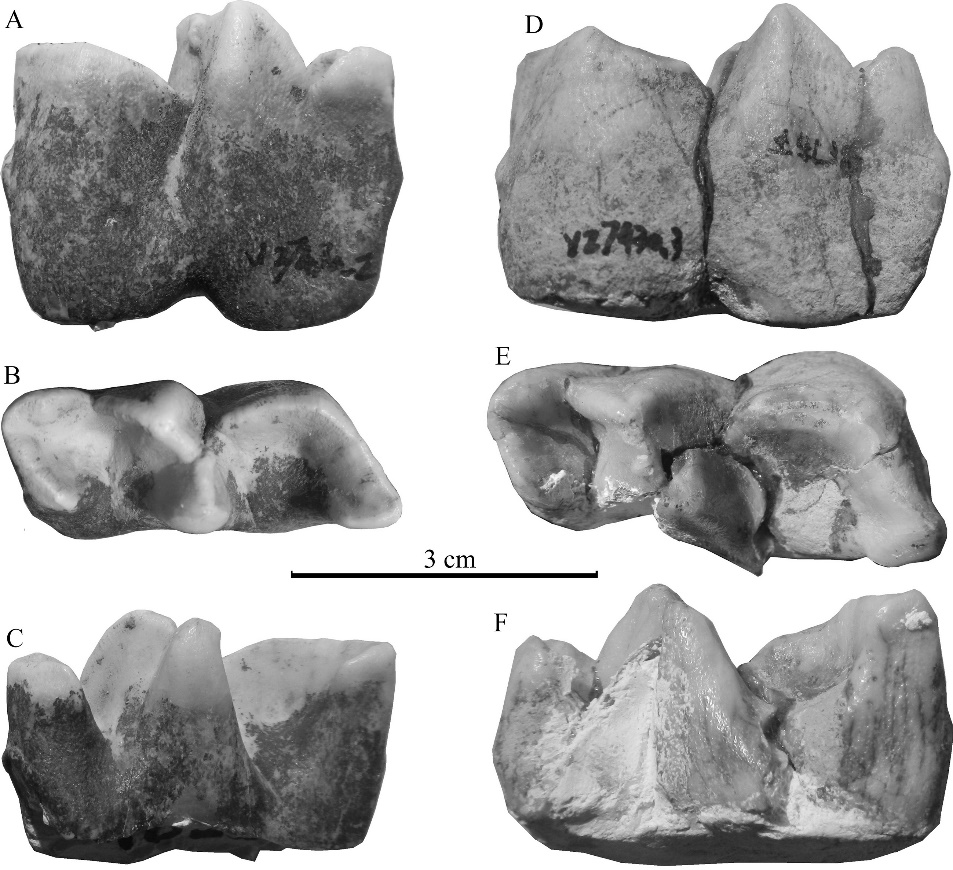
Fig. 8 Deciduous cheek teeth of Coelodonta nihowanensis from Xinyaozi Ravine A-C. right dp3 (IVPP V 27430.2); D-F. right dp4 (V 27430.3) A, D. buccal view; B, E. occlusal view; C, F. lingual view
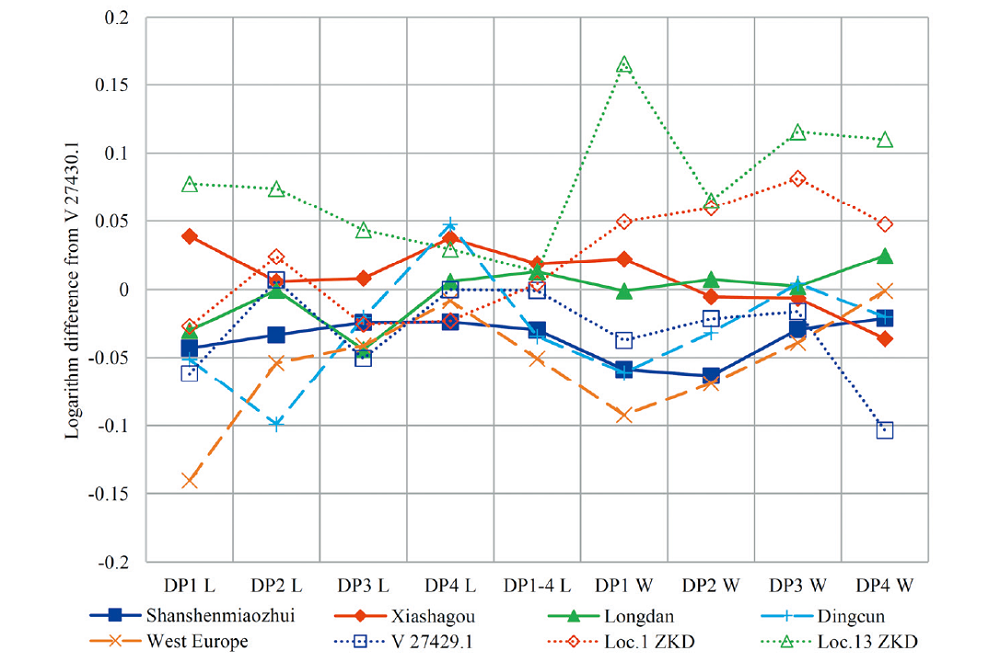
Fig. 9 Ratio diagram of dimensions of upper deciduous cheek teeth from related localities, plotted against those of IVPP V 27430.1 (reference 0) Note: Data source as in Tables 2, 5. L. length; W. width; ZKD. Zhoukoudian; solid line, Coelodonta nihowanensis ; dash line, C. antiquitatis ; dotted line, Stephanorhinus kirchbergensis
| [1] | Antoine P-O, 2002. Phylogénie et évolution des Elasmotheriina (Mammalia, Rhinocerotidae). Mém Mus Natl Hist Nat, 188:1-359 |
| [2] |
Antoine P-O, Downing K F, Crochet J-Y et al., 2010. A revision of Aceratherium blanfordi Lydekker, 1884 (Mammalia: Rhinocerotidae) from the Early Miocene of Pakistan: postcranials as a key. Zool J Linn Soc, 160:139-194
DOI URL |
| [3] |
Bai W P, Dong W, Zhang L M et al., 2019. New material of the Early Pleistocene spiral horned antelope Spirocerus (Artiodactyla, Mammalia) from North China and discussion on its evolution. Quatern Int, 522:94-102
DOI URL |
| [4] | Belayeva (Beliajeva) E I, 1966. Rhinocerotidae. In: Vangengeim E A et al. eds. Eopleistocene Mammals of Western Transbaikalia. Moscow: NAUKA. 92-143 |
| [5] | Borissiak (Borissjak) A, 1914. Sur la dentition d'Elasmotherium caucasicum n. sp. Bull Acad Imp Sci St-Pétersbourg, Sér 6, 8(9):555-558 |
| [6] | Boule M, Breuil H, Licent E et al., 1928. Le Paléolithique de la Chine. Arch Inst Paléont Hum, Mém, 4:1-136 |
| [7] | Chia L P, Wang J, 1978. Hsihoutu—a Culture Site of Early Pleistocene in Shansi Province. Beijing: Cultural Relics Publishing House. 1-85 |
| [8] | Chow B S, 1978. The distribution of the woolly rhinoceros and woolly mammoth. Vert PalAsiat, 16(1):47-59 |
| [9] | Chow B S, 1979. The fossil rhinocerotids of locality 1, Choukoutien. Vert PalAsiat, 17(3):236-258 |
| [10] | Chow M C, 1958. New elasmotherine rhinoceroses from Shansi. Vert PalAsiat, 2(2-3):131-142 |
| [11] | Colbert E H, Hooijer D A, 1953. Pleistocene mammals from the limestone fissures of Szechwan, China. Bull Am Mus Nat Hist, 102:1-134 |
| [12] | David A, Eremeico N, 2003. Findings of Elasmotherium cf. peii (Chow Minchen, 1958) from sediments of Early Pleistocene (Upper Villafranchian) at Salcia (Republic of Moldova). In: Petculescu A, Ştiucă E eds. Advances in Vertebrate Paleontology “Hen to Panta”. Bucuresti: Institute of Speleology, Romanian Academy & “E. Racovita”. 17-24 |
| [13] | Deng T, 2002. The earliest known wooly rhino discovered in the Linxia Basin, Gansu Province, China. Geol Bull China, 21:604-608 |
| [14] |
Deng T, 2003. New material of Hispanotherium matritense (Rhinocerotidae, Perissodactyla) from Laogou of Hezheng County (Gansu, China), with special reference to the Chinese Middle Miocene elasmotheres. Geobios, 36:141-150
DOI URL |
| [15] |
Deng T, 2004. A new species of the rhinoceros Alicornops from the Middle Miocene of the Linxia Basin, Gansu, China. Palaeontology, 47(6):1427-1439
DOI URL |
| [16] |
Deng T, 2005. New discovery of Iranotherium morgani (Perissodactyla, Rhinocerotidae) from the Late Miocene of the Linxia Basin in Gansu, China and its sexual dimorphism. J Vert Paleont, 25:442-450
DOI URL |
| [17] |
Deng T, 2008. A new elasmothere (Perissodactyla, Rhinocerotidae) from the Late Miocene of the Linxia Basin in Gansu, China. Geobios, 41:719-728
DOI URL |
| [18] | Deng T, Zheng M, 2005. Limb bones of Elasmotherium (Rhinocerotidae, Perissodactyla) from Nihewan (Hebei, China). Vert PalAsiat, 43(2):110-121 |
| [19] |
Deng T, Wang X M, Fortelius M et al., 2011. Out of Tibet: Pliocene woolly rhino suggests high-plateau origin of Ice Age megaherbivores. Science, 333:1285-1288
DOI PMID |
| [20] |
Deng T, Wang S Q, Hou S K, 2013. A bizarre tandem-horned elasmothere rhino from the Late Miocene of northwestern China and origin of the true elasmothere. Chinese Sci Bull, 58(15):1811-1817
DOI URL |
| [21] |
Dong W, Wei Q, Bai W P et al., 2019. New material of the Early Pleistocene Elaphurus (Artiodactyla, Mammalia) from North China and discussion on taxonomy of Elaphurus . Quatern Int, 519:113-121
DOI |
| [22] | Dong W, Bai W P, Pan Y et al., 2020. New material of Cervidae (Artiodactyla, Mammalia) from Xinyaozi Ravine in Shanxi, North China. Vert PalAsiat, 58(3):221-248 |
| [23] | Fortelius M, Mazza P, Sala B, 1993. Stephanorhinus (Mammalia: Rhinocerotidae) of the western Europe Pleistocene, with a revision of S. etruscus (Falconer, 1868). Palaeontogr Ital, 80:1-16 |
| [24] | Guérin C, 1980. Les rhinocéros (Mammalia, Perissodactyla) du Miocène terminal au Pléistocène supérieur en Europe occidentale. Doc Lab Géol Lyon, 79(1-3):1-1185 |
| [25] |
Hou Y M, Yang S X, Dong W et al, 2013. Late Pleistocene representative sites in North China and their indication of evolutionary human behavior. Quatern Int, 295:183-190
DOI URL |
| [26] | Jiang P, 1977. A new subspecies of Coelodonta antiquitatis. Vert PalAsiat, 15(3):207-210 |
| [27] | Kahlke H-D, 1969. Die Rhinocerotiden-Reste aus den Kiesen von Süßenborn bei Weimar. Paläont Abh A, 3:667-709 |
| [28] |
Kahlke R D, Lacombat F, 2008. The earliest immigration of woolly rhinoceros (Coelodonta tologoijensis , Rhinocerotidae, Mammalia) into Europe and its adaptive evolution in Palaearctic cold stage mammal faunas. Quat Sci Rev, 27:1951-1961
DOI URL |
| [29] | Li Y, 1984. The Early Pleistocene mammalian fossils of Danangou, Yuxian, Hebei. Vert PalAsiat, 22(1):60-68 |
| [30] | Liu P, Deng C L, Li S H et al., 2012. Magnetostratigraphic dating of the Xiashagou Fauna and implication for sequencing the mammalian faunas in the Nihewan Basin, North China. Palaeogeogr Palaeoclimat Palaeoecol, 315(5):75-85 |
| [31] | Pei S W, 2001. Discovery of Coelodonta antiquitatis from Hutouliang in Nihewan Basin. Vert PalAsiat, 39(1):72-75 |
| [32] | Pei W C, 1958. Description of mammalian fossils. In: Pei W C ed. Report on the Excavation of Palaeolithic Sites at Tingtsun, Hsiangfenhsien, Shansi Province, China. Mem Inst Vert Paleont Paleoanthrop, Acad Sin (2). Beijing: Science Press. 21-74 |
| [33] |
Prothero D R, Manning E, Hanson C B, 1986. The phylogeny of the Rhinocerotoidea (Mammalia, Perissodactyla). Zool J Linn Soc, 87:341-366
DOI URL |
| [34] | Qi G Q, 1975. Quaternary mammalian fossils from Salawusu River District, Nei Mongol. Vert PalAsiat, 13(4):239-249 |
| [35] | Qiu Z X, 2002. Hesperotherium - a new genus of the last Chalicotheres. Vert PalAsiat, 40(4):317-325 |
| [36] | Qiu Z X, Wang B Y, 2007. Paracerathere fossils of China. Palaeont Sin New Ser C, 29:1-396 |
| [37] | Qiu Z X, Wei Q, Pei S W et al., 2002. Preliminary report on Postschizotherium (Mammalia: Hyarcoidea) material from Tianzhen, Shanxi, China. Vert PalAsiat, 40(2):146-160 |
| [38] | Qiu Z X, Deng T, Wang B Y, 2004. Early Pleistocene mammalian fauna from Longdan, Dongxiang, Gansu, China. Palaeont Sin, New Ser C, 27:1-198 |
| [39] | Shvyreva A K, 1995. History of the rhinoceros Elasmotherium . Stavropol: G. N. Prozriteleva & G. K. Prave. 1-104 |
| [40] | Tang Y J, Zong G F, Xu Q Q, 1983. Mammalian fossils and stratigraphy of Linyi, Shanxi. Vert PalAsiat, 21(1):77-86 |
| [41] | Tang Y J, Li Y, Chen W Y, 1995. Mammalian fossils and the age of Xiaochangliang Paleolithic Site of Yangyuan, Hebei. Vert PalAsiat, 33(1):74-83 |
| [42] | Teilhard de Chardin P, 1936. Fossil mammals from locality 9 of Choukoutien. Palaeont Sin, Ser C, 7(4):1-61 |
| [43] | Teilhard de Chardin P, Leroy P, 1942. Chinese fossil mammals. Inst Géo-Biol, 8:1-142 |
| [44] | Teilhard de Chardin P, Pei W C, 1941. The fossil mammals from Locality 13 of Choukoutien. Palaeont Sin, New Ser C, 11:1-106 |
| [45] | Teilhard de Chardin P, Piveteau J, 1930. Les mammifères fossils de Nihowan (Chine). Ann Paléont, 19:1-134 |
| [46] | Tong H W, 2002. Dicerorhinus mercki (Jager). In: Wu R K et al. eds. Homo erectus from Nanjing. Nanjing: Jiangsu Science and Technology Publishing House. 111-120 |
| [47] | Tong H W, Moigne A M, 2000. Quaternary rhinoceros of China. Acta Anthrop Sin, 19(Supp):257-263 |
| [48] |
Tong H W, Wang X M, 2014. Juvenile skulls and other postcranial bones of Coelodonta nihowanensis from Shanshenmiaozui, Nihewan Basin, China. J Vert Paleont, 34(3):710-724
DOI URL |
| [49] |
Tong H W, Wu X Z, 2010. Stephanorhinus kirchbergensis (Rhinocerotidae, Mammalia) from the Rhino Cave in Shennongjia, Hubei. Chinese Sci Bull, 55:1157-1168
DOI URL |
| [50] | Tong H W, Tang Y J, Yuan B Y, 2011. Biostratigraphy division of vertebrate fossils. In: Yuan B Y, Xia Z K, Niu P S eds. Nihewan Rift and Ancient Human. Beijing: Geological Publishing House. 47-60 |
| [51] | Tong H W, Wang F G, Zheng M et al., 2014. New fossils of Stephanorhinus kirchbergensis and Elasmotherium peii from the Nihewan Basin. Acta Anthrop Sin, 33(3):369-388 |
| [52] | Wei Q, 1997. The framework of archaeological geology of the Nihewan Basin. In: Tong Y S, Zhang Y Y, Wu W Y et al. eds. Evidence for Evolution-Essays in Honor of Prof. Chungchien Young on the Hundredth Anniversary of His Birth. Beijing: China Ocean Press. 193-207 |
| [53] | Wei Q, Meng H, Cheng S Q, 1985. New Palaeolithic site from the Nihewan (Nihowan) beds. Acta Anthrop Sin, 4(3):223-232 |
| [54] | Xu X F, 1986. Dicerorhinus kirchbergensis (Jager, 1839) from the late Middle Pleistocene mammalian fauna of Anping, Liaoning. Vert PalAsiat, 24(3):229-241 |
| [55] |
Yan Y L, Wang Y, Jin C Z et al., 2014. New remains of Rhinoceros (Rhinocerotidae, Perissodactyla, Mammalia) associated with Gigantopithecus blacki from the Early Pleistocene Yanliang Cave, Fusui, South China. Quatern Int, 354:110-121
DOI URL |
| [56] |
Zhang L M, Griggo C, Dong W et al., 2016. Preliminary taphonomic analyses on the mammalian remains from Wulanmulan Paleolithic Site, Nei Mongol, China. Quatern Int, 400:158-165
DOI URL |
| [57] | Zhang Z H, Zou B K, Zhang L K, 1980. The discovery of fossil mammals at Anping, Liaoyang. Vert PalAsiat, 18(2):154-162 |
| [58] | Zheng S H, Wu W Y, Li Y et al., 1985. Late Cenozoic mammalian faunas of Guide and Gonghe Basins, Qinghai Province. Vert PalAsiat, 23(1):89-134 |
| Viewed | ||||||
|
Full text |
|
|||||
|
Abstract |
|
|||||